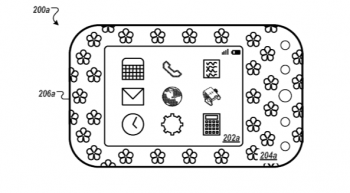
Google imagines phones wrapped in one giant display [PATENT]
Say what you want about Google, but the Mountain View tech giant is always thinking about innovation in everything they do. This latest patent is proof positive of that, with Google exploring unique ways to use displays as the chassis for a smartphone device.
The patent — which Google aptly titled “mobile electronic device wrapped in electronic display” — shows that Google is exploring the possibility of using extended and flexible displays to show wallpapers, information or icons outside the typical scope of a device’s main display.
How it works
Think of your phone’s current build — with plastic or metal bezels surrounding the screen, on the sides of the device, and on the back of the device — and how you’d use something like a case or stickers to personalize it. With this idea you’d be able to do it all digitally, giving you the ability to get the exact look you want and even change it up if you get bored with it.
The patent also details the “wrapping” of the display around the backside of a device or up to the outer edges that connects the front chassis to the back of the device. We imagine this would appear as some sort of ticker on the side that can feed you minimal information while keeping the rest of the display off, something that AMOLED technology could facilitate.
The other examples Google presented were interesting in their own light. One figure from the patent document illustrated using the display to show an extended wallpaper that would give users a way to dynamically customize the look of their device without having to use skins or cases.
Another example used the display to show parts of other pages of your home-screen that would normally be hidden, as well as widgets for date, time and weather. There were also examples of information scrolling from one edge of a device to another. All of these different examples can be seen in the figures above and below.
Could this work well?
We’re not sure how well all of this would function in practice, but it definitely has our interests piqued in theory. Technology like this stands to be scrutinized by those who are concerned with battery life, of course. A secondary display does have us wondering if this would be more detrimental than helpful to typical mobile experiences.
We also have reservations about the design aspect of it — just how “sexy” can a device look with its chassis made up of nothing but displays? How pretty will it be when the device is completely powered down or in sleep mode?
Those are questions that can only be answered with a tangible example, so we’ll have to wait and see if anyone has plans of introducing a device like the ones Google described. As with any patent, though, there’s no telling if we’ll ever see this implemented in consumer or prototype form, but we’re glad Google’s staying on the ball when it comes to innovative ideas.